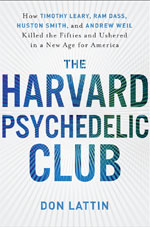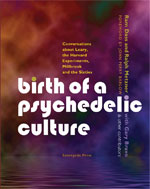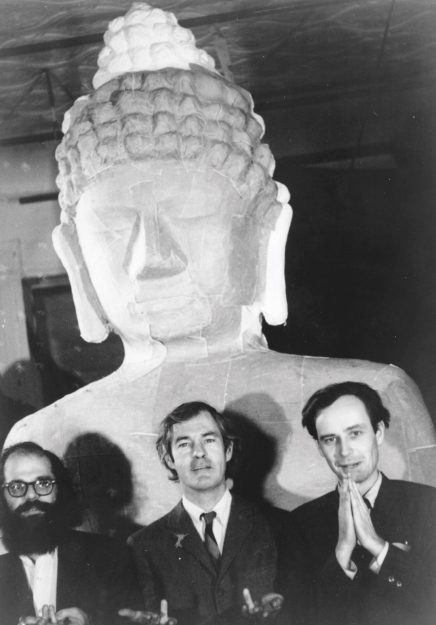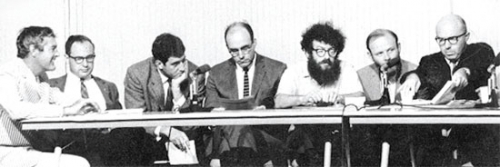 The Harvard Psychedelic Club: How Timothy Leary, Ram Dass, Huston Smith, and Andrew Weil Killed the Fifties and Ushered in a New Age for America
The Harvard Psychedelic Club: How Timothy Leary, Ram Dass, Huston Smith, and Andrew Weil Killed the Fifties and Ushered in a New Age for America
Don Lattin
HarperOne, 2010
272 pp., $24.99 cloth
 Birth of a Psychedelic Culture: Conversations about Leary, the Harvard Experiments, Millbrook and the Sixties
Birth of a Psychedelic Culture: Conversations about Leary, the Harvard Experiments, Millbrook and the Sixties
Ram Dass and Ralph Metzner with Gary Bravo and other contributors
Foreword by John Perry
Barlow Synergetic Press, 2010
264 pp., $29.95 paper
Ever since psychedelics (from the Greek for “mind-manifesting”) first came into use in the West, Buddhism has had to deal with them. Many students of Buddhism have become interested in psychedelics, and many users of these substances have become interested in Buddhism. In the sixties and early seventies, zendos and meditation halls were flooded with young people who had experimented with LSD, psilocybin, mescaline, and other hallucinogens and were now seeking a more sustainable way to continue their spiritual development. Each abbot, each temple, each teacher of the dharma had to formulate a policy on psychedelic use. As David Chadwick, a San Francisco Zen Center priest, put it, “Regardless of whether we view these psychoactives as helpful in the short or long haul, it’s clear they have been and continue to be pivotal catalysts in the spiritual journey of a multitude of seekers.”
Most of the American-born dharma teachers who came along in the seventies and eighties had tried psychedelics, and many regarded them as a gateway to deeper understanding of Buddhist ideas. While there were teachers who felt that students who used psychedelics extensively were not well suited to practice, others found that students who took hallucinogens often excelled in their Buddhist studies.
“A dynamic back-and-forth relationship between psychedelic use and Eastern spirituality has existed since the nineteenth century,” wrote the late Rick Fields, a longtime Buddhist practitioner, in an article for the Fall 1996 issue of Tricycle. “In the fifties, Buddhist and Hindu texts inspired aristocratic British exiles like the writers Gerald Heard and Aldous Huxley to seek experiential illumination through psychedelics. In the sixties, the same psychedelic experience inspired American academicians like Timothy Leary and Richard Alpert (Ram Dass) to investigate Eastern texts and practices.”

Two recent books explore those early days in the American psychedelic revolution, and while their simultaneous arrival is coincidental, it is fortunate for students of both Buddhism and psychedelics to have such rich reminders of this fascinating and formative moment in the long history of psychoactive plants in human society. Birth of a Psychedelic Culture contains reminiscences from the vanguard of the psychedelic movement. The book centers on conversations about the good old days between onetime Harvard professor Richard Alpert, later known as Ram Dass, and Ralph Metzner, a psychologist and author who was a graduate student at Harvard when Alpert and his colleague Timothy Leary were conducting their experiments in psilocybin and LSD. The dialogue is deftly moderated by psychiatrist Gary Bravo, and there’s a breezy, beautifully written introduction by John Perry Barlow, a Harvard graduate, Grateful Dead lyricist, and computer pioneer who by the mid-Sixties was also “fully enrolled in the Eastern Orthodox Church of LSD,” as he puts it. Revelations about the Harvard Psilocybin project (later the Harvard Psychedelic project), about Leary and Alpert’s continued experimentation with psychedelics in a Millbrook, New York mansion, and about their sojourns to Mexico and India offer a sensational—and at times riveting—contribution to our understanding of a complex and confusing issue.
Peppered with recollections from lesser-known members of Alpert and Leary’s circle, Birth serves as a kind of scrapbook of the psychedelic movement. The detailed descriptions of their specific drug “journeys,” along with insights about the various substances they ingested, are particularly interesting. Numerous cultural figures play supporting roles in the drama, including Aldous Huxley (everyone’s inspiration, it seems), radical psychiatrist R. D. Laing, musicians Charles Mingus and Maynard Ferguson, and writers Allen Ginsberg and William Burroughs. Black-and-white photographs of the pioneers serve as a visual timeline of the transformation in their physiognomies that accompanied the transformation of their minds.
The second of the two books, The Harvard Psychedelic Club: How Timothy Leary, Ram Dass, Huston Smith, and Andrew Weil Killed the Fifties and Ushered in a New Age for America, is by Don Lattin, a well-known San Francisco religion journalist who came to Zen Buddhism via LSD. Lattin tells the story of the quest for expanded consciousness in reconstructed conversations and four interwoven threads, focused on the men he calls the Trickster (Timothy Leary), the Seeker (Richard Alpert/Ram Dass), the Teacher (Huston Smith, a religion professor at MIT), and the Healer (Andrew Weil, then a Harvard undergraduate). The four are cast as epic cultural creatives at the forefront of the human potential movement, whose radical ideas killed the conservative, conformist fifties and forever changed the trajectory of our lives. Lattin concentrates on Leary and his relationship with Alpert, skillfully avoiding the temptation to glorify or rebuke Leary, and instead bringing forth a textured and nuanced portrait of the man who famously encouraged a generation of seekers to “turn on, tune in, drop out.” An even more vivid picture of Leary emerges from Birth of a Psychedelic Culture, the observations of Leary’s partners having benefited from the years they’ve had to contextualize events as well as their own actions.

Both books are hard to put down, for different reasons. Lattin’s storytelling—wry, concise, and compelling, often inferring what it doesn’t freely admit—keeps a half-smile on the reader’s face. His streamlined narrative is potentially confusing— events do not always chronologically follow—but the conclusions he draws feel right nevertheless. In Birth, Metzner and Ram Dass come to terms with the behavior that led Leary to ban Alpert from Millbrook, including Alpert’s pot smoking and predilection for sex in public places.
Together the two books give us a visceral sense of what these men were about—their great strengths, their failings—as well as the historical importance of their early experimentation. Both Leary and Alpert had difficulty sustaining relationships: Leary was married five times; Alpert had “a voracious omni-sexual appetite,” as Lattin describes it; and both traded on their psychoactive booty for sex. Both books also plumb the real story of how Leary and Alpert were kicked out of Harvard, and the role played by Andrew Weil. Only eighteen when he met Alpert and Leary, but with lofty ambitions, Weil was enraged when Alpert refused to give him LSD, saying he was too young to take psychedelics—then turned around and gave it to Weil’s best friend. Weil in turn wrote a scandalous exposé of Alpert and Leary’s research for the Harvard Crimson that gave the administration the ammunition to fire renegade professors.
One might be tempted to think of Weil’s actions as reprehensible, but to his young eyes, it was equally appalling for the professors to have so much fun behind the cover of scientific research, apparently picking and choosing study participants based on their attractions. With the light of hindsight, Weil later offered his apologies, but it may well have been this very incident that catapulted Leary and Alpert into the national spotlight. As Weil’s exposé was splashed all over the media, it gave them the soapbox from which to educate the world about the potential of psychedelics to assist in human evolution. Weil, meanwhile, never revealed his own drug use at Harvard: after Alpert refused to give him LSD, he managed to secure mescaline and conduct his own psychedelic experiments in his dorm.
As for Metzner, in Birth of a Psychedelic Culture he finally gets his chance to tell the story as he saw it—a version that often contrasts with how Leary told it in Flashbacks, High Priest, and other autobiographical writings. A brilliant thinker and smooth operator who was apparently an invaluable companion to Leary, Metzner was able in his conservative and gentle way to maximize all the advantages of being a “member of the club” without letting any of the antics unravel him.
In fact, for all their drug use, the members of the club seem to have emerged largely unscathed, going on to become highly accomplished and successful. Metzner, a professor emeritus and former academic dean at the respected California Institute of Integral Studies, and an author, set up the Green Earth Foundation to educate others on con- sciousness,shamanism, and our interdependence with all living things. Huston Smith, now 91 and arguably the world’s foremost advocate of religious tolerance, was the subject of a Bill Moyers TV series, and his book The World’s Religions has sold more than 2 million copies. Weil went on to become a prominent physician and author, American’s best-known expert on integrative medicine and nutrition.
Always the most flamboyant and eccentric of the group, Leary, whose drugrelated advocacy landed him in jail on several occasions, became a best-selling author and popular lecturer before his death in 1996. But despite his roles as godfather to the counterculture, pied piper of LSD, friend of the Beatles, and enthusiast for cyberspace, he is not fondly remembered by some of the players in the psychedelic milieu. Owsley Stanley, a counterculture chemist who was the major producer of LSD before it became illegal, wrote that Leary was an unabashed seeker of celebrity, and is quoted in Jay Stevens’s book Storming Heaven as saying that Leary “did inestimable damage to the psychedelic movement. The draconian [drug] laws dating from 1966 are almost entirely of his doing.” Still, it was hard not to like Leary—he was brilliant, charismatic, and fearless in the face of prosecution, fond of saying that “LSD is a drug that produces fear in people who don’t take it.”
Richard Alpert may be even more complicated and interesting than Leary. After parting ways with Leary, Alpert became Ram Dass, the leading Western guru of Eastern mysticism, writing the seventies bible Be Here Now and co-founding the Seva Foundation, which sponsors health-related programs in Asia. Even after a crippling stroke, Ram Dass still personifies “compassion in action.”
The late Terence McKenna talked about creating a society that “always lives in the light of the mystery of being,” one that “would abandon belief systems [in favor of] direct experience.” The solution to all our problems, he suggested, lies in the emergence of a new global culture consisting of four elements: feminism, ecology, Buddhism, and psychedelics. It would honor the feminine, revere the planet, and promote compassion, with psychedelics as the tool to revivify and make coherent the other three.
Now McKenna’s vision may be coming true, at least in part. Thanks to the perspective only time can bring—and a relaxing of government restrictions on psychedelics research—a new era is dawning. Whereas the Harvard “club” relied mainly on psilocybin and LSD, other, older substances are now coming to the fore: ayahuasca from the Amazon basin, ibogaine from West Africa, salvia divinorum from Mexico. MDMA (Ecstasy) was rediscovered in a California lab and became a staple first of psychotherapy and later of the underground rave culture. Scientific study of the healing powers of psychoactive plants has begun anew, and knowledge of their many uses is more widely known. Nonprofit organizations like MAPS (Multidisciplinary Association for Psychedelic Studies), DPA (Drug Policy Alliance), and the Heffter Research Institute are at the vanguard of this shift.
From the colorful characters in Birth of a Psychedelic Culture and The Harvard Psychedelic Club we learn not only the value of psychedelics but also that hallucinogens are not “the” answer. The postpsychedelic phase of the pioneers’ lives was just as problem-laden as anyone else’s, if not more so—rife with interpersonal feuds, self-aggrandizement, ego-battles, and addictions. Huston Smith made an apropos distinction: “While psychedelic use is all about altered states, Buddhism is all about altered traits, and one does not necessarily lead to the other.” When Metzner was asked by an interviewer if he thought that society had changed as a result of psychedelic use, he replied that it was impossible to say. “I believe that the important thing is not drugs per se, but the notion and practice of expanding consciousness and taking many more perspectives into account in all situations…. After all,” he added, “Charles Manson used LSD, and look at what he did with it. What good was that?”